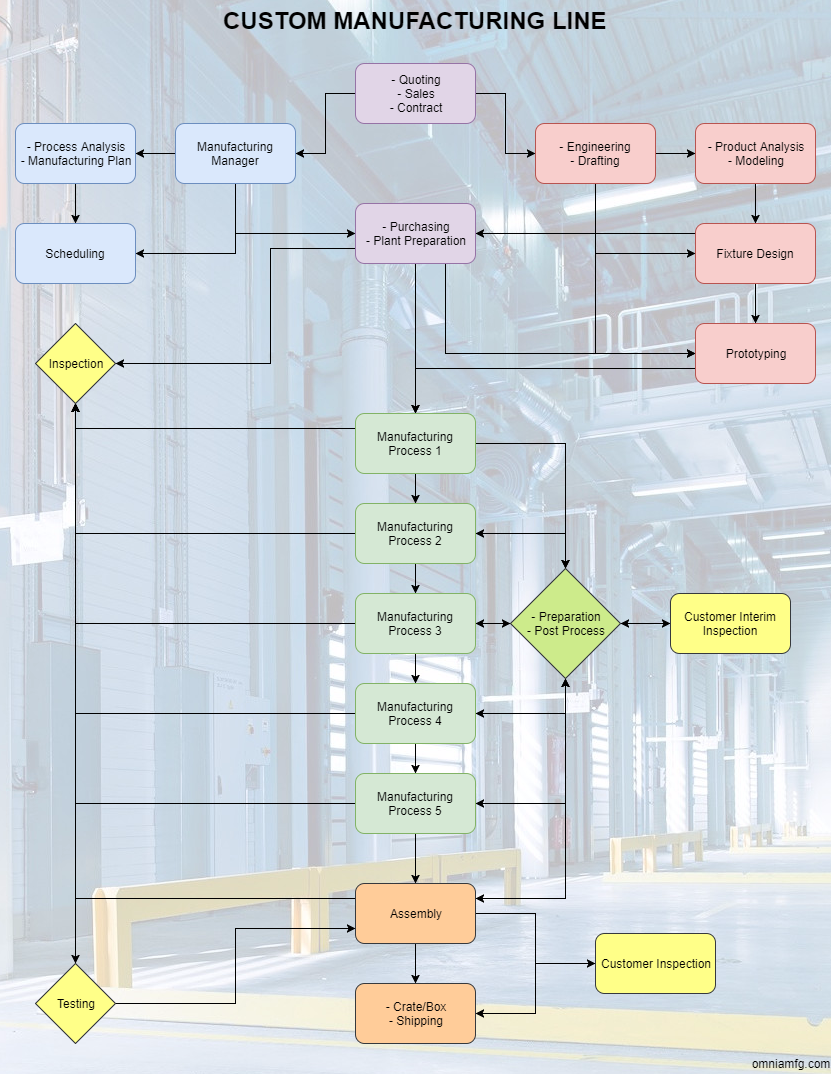The Custom Manufacturing Plan
Custom manufacturing facilities engineer manufacturing processes for a wide range of products primarily in low volume and at a variety of complexity. Engineers and highly detail oriented employees create a culture of fast paced process and product analysis and follow-through of a calculated manufacturing plan. Factories of this nature often rely on both internal processes as well as external partnerships to perform as many manufacturing processes as necessary to produce the requested custom part.
The custom manufacturing line is nearly identical to that of a standard high volume manufacturing line, but requires a more thorough inspection process and is called upon at the start of newly accepted contract.
The below infographic shows a basic example of a custom manufacturing line for an assembly, whether it be mechanical or electro-mechanical. The assembly includes:
- Contract acceptance
- Development of manufacturing plan
- Product analysis
- Scheduling
- Plant preparation
- Fixture design
- Prototyping
- Manufacturing processes
- Inspection
- Part preparation/post process
- Testing
- Customer inspection
- Assembly
- Shipping
In many cases of larger assemblies, the manufacturing plan will be split into multiple manufacturing lines to accommodate lower level assemblies and sub-assemblies prior to the final assembly. Many custom manufacturing lines also include a risk management section that explores the necessary processes to fix likely imperfections and complications. These sections are represented as loops including an “inspection” block, a “testing” block, a “manufacturing process” block, and sometimes the “engineering” block (drafting, product analysis, modeling, fixture design, prototyping, etc.). Also included are possibly scheduling changes and manufacturing plan changes as a result of risk management.
Basic example of a custom manufacturing line including quoting, management, engineering, manufacturing processes, and inspection.
Inside and Outside Departments
In many cases, primarily in smaller factories, a custom manufacturing company must limit their internal departments, allowing scale through outside partnerships. Internal processes that can be scaled and profitable or that are important to closely control are chosen carefully and will sometimes change as different types of contracts are accepted.
External partnerships and outside processes are called on for expertise in specialized areas. In many cases, it is not worth investing in a process that cannot be scaled, therefore, calling on an external partnership that has already scaled the process is easier to justify.
In the manufacturing line, the external processes should be classified as an external department and will require extra monitoring at lower risk.
Schedule Management
All types of manufacturing revolve around the master schedule. In large assemblies, the master schedule can be affected dramatically if an issue arises early in the manufacturing plan. Ultimately, change in schedule = earlier or later return on investment.
When developing the manufacturing line and schedule, the ordering of parts and anticipation of process lead time should be carefully considered such that a single part is not idly waiting on another part, process, or lead time. Far too many times (in custom job shops as well as large scale manufacturing) has a small part such as a rivet been the cause of delay due to lead time, damage, or negligence. As parts sit idle, the factory loses money.
Manufacturing Engineering – Fixture Development
In most cases, and primarily in high precision manufacturing, fixtures are developed in order to reduce human error in all manufacturing processes. Complex assemblies and operations will require multiple fixture setups as well as modular fixturing that will allow consistent results. Fixture development, in many cases, stems from the development of prototypes and proof of concepts. CAD/CAM programs are useful in these operations.
Lean Manufacturing and Agile Manufacturing
Modern custom manufacturing facilities must develop strategies similar to software technology companies in order to be competitive. Agile starts with the training of employees to have an entrepreneurial mindset and the ability to work on multiple projects at the same time.
The interruption of a manufacturing line should be commonplace yet not disruptive, as internal priorities will change consistently. Mobile equipment and employees willing to take on leadership roles aid the agile momentum.
Projects should be collaborated upon in small teams in parallel to all other projects, only limited based on priority level. External manufacturing partnerships will be able to offset “bottleneck” risk and should be considered as an alternative or additive to every new custom manufacturing line.
Jarrett Linowes
Mechanical Engineer
omniamfg@gmail.com
Did I miss anything you are interested in? Send me an email or comment below!






